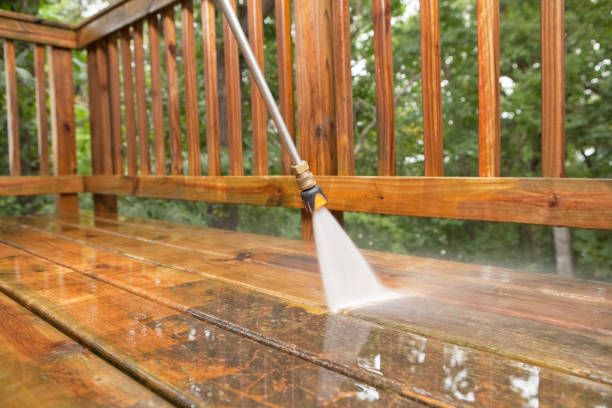
pressure washing services
Why Decks Fade—and How to Bring Them Back: Sun, rain, and foot traffic wear decks down fast. Boards turn gray. The grain looks dull. Dirt packs into the wood. Soon, the space you love feels tired. However, there is a clear path back. Smart washing methods can remove oxidized layers and ground-in grime. Then, sealing can lock in color and reduce future wear. With Deep Cove pressure washing services, you get careful cleaning that respects wood, not harsh blasting. In this guide, you will see how pressure, cleaners, and technique work together. Most importantly, you will see less slip, richer color, and fewer big repairs later. Let’s walk through what actually restores a faded deck—and what harms it.
What Really Fades a Deck—and What Deep Cove Pressure Washing Services Restores It
When pressure washing services evaluate your deck, the first step is understanding the cause. UV light breaks down lignin, which holds fibers together. Algae traps moisture and stains the surface. Dirt and tannins darken boards. Therefore, the fix must target each issue. Pressure alone is not enough. The right cleaner loosens the mess. Then controlled rinsing carries it away without carving the wood. Because the goal is long-term health, each step should protect the grain for sealing.
| Problem Source | What It Does | What Helps Most | What to Avoid |
|---|---|---|---|
| Sun/UV | Gray’s wood dries fibers | Oxygen-based brightener | Harsh sanding of soft grain |
| Algae/Mildew | Slippery film, dark stains | Algaecide + dwell time | Straight bleach on raw wood |
| Dirt/Tannins | Blotches, uneven tone | Mild detergent + rinse | High PSI near edges |
| Old Sealers | Patchy color, flaking | Stripper, then rinse | Layering sealer over debris |
With the cause clear, every pass becomes safer and more effective.
“Less Pressure, More Control” — How Pros Clean Without Damage
Uncontrolled pressure can damage decking, which is why PSI must match the wood type. Cedar and pine respond best to low force and wide spray tips, while hardwoods can tolerate slightly higher pressure only with steady distance and motion. By keeping the wand moving, stripes and swirl marks are avoided. This approach forms the core of how Deep Cove pressure washing services safely restore and protect decks.
Equally important, the grain direction guides every pass. Cleaning with the grain maintains an even surface and protects the fibers. The rinse uses overlapping strokes, flushing out residue instead of pressing it deeper. The result is a brighter deck, free of buildup, with intact fibers—ready for a protective sealer to bond effectively.
Prep Steps That Boost Results
Good prep saves time and protects plants. It also improves the final look. Before any wash, pressure washing guides a simple setup so the clean goes smoothly.
- Remove furniture and rugs; check for loose nails or screws.
- Sweep debris, then dry-scrub heavy moss to expose wood.
- Cover plants and outlets; tape keyholes and nearby fixtures.
- Wet surrounding landscaping to buffer any overspray.
- Test an inconspicuous board to validate PSI and cleaner.
These quick steps reduce surprises. They also help cleaners reach the grime evenly, which means a more uniform finish.
Choosing Cleaners the Smart Way
- Match the Mess
Different soils need different chemistry. Algae prefer an algaecide. Tannins respond to oxygen-based brighteners. Oil and grill splatter need a degreaser. When cleaners match the mess, you can use lower pressure and fewer passes.
- Respect the Wood
Old boards can be porous and fragile. Therefore, dwell times stay short and controlled. Rinses are thorough. Runoff is managed so nearby beds stay safe. Because the goal is restoration, not just “looking clean,” the wood’s surface must remain strong.
- Rinse for Bonding
After cleaners lift grime, full rinses matter. Any leftover residue can block sealer adhesion. A clean, neutral surface helps the next step last longer and look more even across all boards.
“Clean, Then Seal” — Locking in the Fresh Look
Keeping decks fresh requires more than cleaning—it requires smart follow-up. That’s why Deep Cove pressure washing services recommend a moisture check before applying any finish. Once dry, penetrating sealers or stains protect against UV and water. These soak into fibers instead of sitting on top, reducing peeling. Transparent choices let the grain shine, while semi-transparent tones add depth with natural texture. Finally, inspect high-traffic paths and steps. They may benefit from a second pass because wear is stronger there.
“Clean without sealing is like washing a car and skipping wax.”
What You Gain Right Away
A deck should look good and function with minimal effort. That’s why Deep Cove pressure washing services focus on practical care that delivers clear, daily results and reduces long-term maintenance.
- Safer footing: algae goes, grip returns, and steps feel secure.
- Richer grain: gray lifts, and natural color becomes visible again.
- Easier cleaning: sealed fibers don’t hold dirt as tightly.
- Better durability: water beads, so boards swell and shrink less.
- Lower costs: regular care prevents deep sanding or full replacement.
These gains show up in the first week. Then, they keep paying off each season as maintenance gets simpler.
Safety, Cost, and Timing: What to Expect + FAQs
Most Deep Cove Pressure Washing Services visits include assessment, cleaning, and an optional sealing plan. Safety comes first. Technicians shield outlets, protect plants, and set exclusion zones. Costs vary with size, soil level, and finish choice. Time depends on drying windows and weather. However, planning in mild seasons helps coatings cure better.
Will pressure washing remove all gray?
Usually, yes, when oxidation is the main cause. Deep UV damage may still show lightly.
Could high pressure harm my deck?
It can. That’s why pros use lower PSI, wider tips, and constant motion.
Do I need to seal after washing?
If you want longer color and fewer stains, sealing is wise.
How long does the new look last?
With basic care, many finishes hold 1–3 years, depending on sun and traffic.
Can I do this myself?
You can, but test carefully. Wrong PSI or a cleaner can leave stripes or fuzzy grain.
Maintenance Map: Keep the Color Season After Season
A simple plan preserves the work. First, sweep weekly during leaf season. Then, rinse lightly each month in dry weather—spot-treat spills near grills. After storms, check stairs and rail caps. They catch water and dirt the most. Each spring, perform a quick water-drop test. If droplets soak in fast, it is time to recoat. If they bead, you can wait. Keep furniture feet clean to avoid ring stains. Use breathable outdoor rugs that dry quickly. Small habits reduce deep stains and keep boards flatter. As a result, the deck stays brighter, safer, and easier to enjoy with family and friends.
Stronger Decks, Brighter Days
A refreshed deck welcomes people outside and protects your investment at the same time. Ready to enjoy a deck that looks better and lasts longer? Schedule your next cleaning and sealing with Tiny Truck Home Services today.


